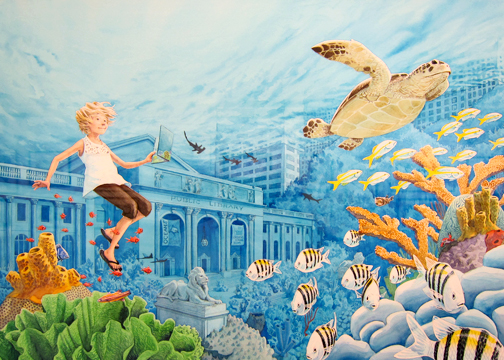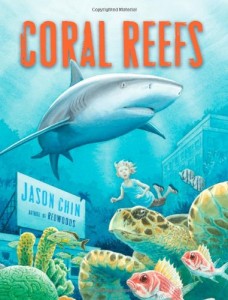 In this exploration of the water cycle, Jason Chin uses watercolor and gouache to paint lovely scenes of a family’s pond-side, rural homestead. Each season is shown in vibrant colors and thoughtful details, and water is shown in a different form on each page. I particularly liked the choice to present the house and its surrounding field and pond from varying angles.
In this exploration of the water cycle, Jason Chin uses watercolor and gouache to paint lovely scenes of a family’s pond-side, rural homestead. Each season is shown in vibrant colors and thoughtful details, and water is shown in a different form on each page. I particularly liked the choice to present the house and its surrounding field and pond from varying angles.
Miranda Paul’s text pulls the reader on to the next page with an unless…, and then reveals the newest transformations. Rhyming words like swirl / curl, misty / twisty, and pack / smack lend a poetic air to the story. Picture books about scientific concepts can sometimes veer into the didactic, but Water Is Water feels like an engaging story about children who love being out in nature.
The two main children in the story are busy in their pursuit of turtles, snakes, and frogs, while their black cat watches their antics from the sidelines. The movement and the motion of the children on each page is a good analogy for the changing water cycle. I also liked the depiction of the children in various forms of play. At home and at school, they are running, chasing, skating, throwing snowballs, and pressing cider.
Of interest to the Sibert committee, if not the Caldecott committee, will be the back matter that includes a deeper exploration of the water cycle, suggestions for further reading, and a select bibliography. It seems as if nonfiction sometimes gets short shrift with award committees. It is difficult to compare the literary qualities of fiction with nonfiction. Is Water Is Water strong enough to overcome a possible bias toward fiction?
The post Water Is Water: A Book about the Water Cycle appeared first on The Horn Book.
By Nina Schuyler, The Children’s Book Review
Published: January 27, 2012
By Jason Chin
Reading level: Ages 5 and up
Hardcover: 40 pages
Publisher: Flash Point (October 25, 2011)
Source: Publisher
What to expect: Science, Nature, Biology, Marine life, Water
Jason Chin does something pretty wonderful in his nonfiction book, Coral Reefs: He hasn’t forgotten the wild imagination of a kid.
What makes Coral Reefs unique is that along with loads of interesting information, he’s included colorful watercolor illustrations that tell their own story. In a sense he is blurring the boundary between fiction and nonfiction. The result is something completely engaging. And this hybrid form dishes out just enough facts without overwhelming. So you learn that though coral reefs may look like plants, they’re actually animals; and at the same time, the pictures, which often take up more than half the page, tell the story of a girl who goes to the library and picks up a book about coral reefs.

Illustration copyright © 2011 by Jason Chin
You learn coral reefs are the largest structures built by an animal on earth! The Belize barrier reef is over 180 miles long!; and at the same time, the illustrations show the girl’s world transforming, with the library slipping away and turning into coral, along with sea plants and fish. “There are so many species living in reefs that they are often called the cities of the sea,” writes Chin. And the water whooshes into the library, and the girl is swept up on a wave that carries with it octopus, sea turtles, fish and more coral. Very quickly, the girl is floating underwater, exploring and learning about the city of the sea. It’s a city, Chin tells us, with “a complex web of relationships, and each has its own place in the system.”
“There are so many species living in reefs that they are often called the cities of the sea,”
After you’ve fallen in love with coral reefs and the teeming life that calls it home—“More than four thousand kinds of fish and thousands of other species have been discovered in coral reefs—more than in any other part of the ocean”—after he’s completely hooked you, Chin has bad news. The reefs, just like so many other living things, are threatened by pollution and over-fishing. Thankfully, he gives a list of things you can do to help. You can—and you’ll want to—form a relationship with the reefs.
Add this book to your collection: Coral Reefs
Nina Schuyler‘s first novel, The Painting, (Algonquin Books of Chapel Hill/2004), was a finalist for the Northern California Book Awards. It was also selected by the San Francisco Chronicle as
 In this exploration of the water cycle, Jason Chin uses watercolor and gouache to paint lovely scenes of a family’s pond-side, rural homestead. Each season is shown in vibrant colors and thoughtful details, and water is shown in a different form on each page. I particularly liked the choice to present the house and its surrounding field and pond from varying angles.
In this exploration of the water cycle, Jason Chin uses watercolor and gouache to paint lovely scenes of a family’s pond-side, rural homestead. Each season is shown in vibrant colors and thoughtful details, and water is shown in a different form on each page. I particularly liked the choice to present the house and its surrounding field and pond from varying angles.



